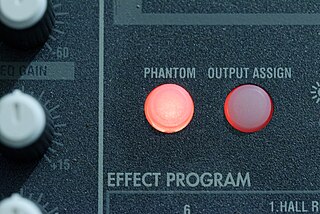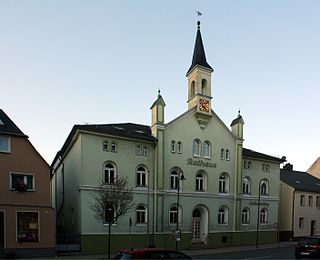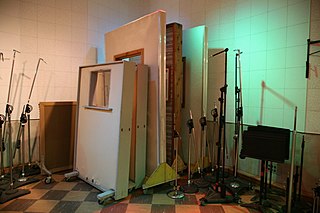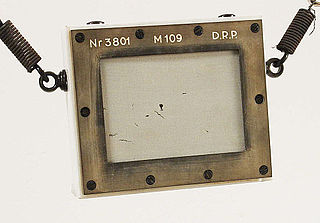
A microphone, colloquially called a mic or mike, is a device – a transducer – that converts sound into an electrical signal. Microphones are used in many applications such as telephones, hearing aids, public address systems for concert halls and public events, motion picture production, live and recorded audio engineering, sound recording, two-way radios, megaphones, radio and television broadcasting. They are also used in computers for recording voice, speech recognition, VoIP, and for non-acoustic purposes such as ultrasonic sensors or knock sensors.

Binaural recording is a method of recording sound that uses two microphones, arranged with the intent to create a 3-D stereo sound sensation for the listener of actually being in the room with the performers or instruments. This effect is often created using a technique known as dummy head recording, wherein a mannequin head is fitted with a microphone in each ear. Binaural recording is intended for replay using headphones and will not translate properly over stereo speakers. This idea of a three-dimensional or "internal" form of sound has also translated into useful advancement of technology in many things such as stethoscopes creating "in-head" acoustics and IMAX movies being able to create a three-dimensional acoustic experience.

Sennheiser electronic GmbH & Co. KG is a German privately held audio company specializing in the design and production of a wide range of high fidelity products, including microphones, headphones, telephone accessories and aviation headsets for personal, professional and business applications. The company's head office is located in Wedemark, near Hanover, and the company is represented in more than 50 countries worldwide.

Phantom power, in the context of professional audio equipment, is DC electric power transmitted through microphone cables to operate microphones that contain active electronic circuitry. It is best known as a convenient power source for condenser microphones, though many active direct boxes also use it. The technique is also used in other applications where power supply and signal communication take place over the same wires.
Telefunken was a German radio and television apparatus company, founded in Berlin in 1903, as a joint venture of Siemens & Halske and the Allgemeine Elektricitäts-Gesellschaft (AEG).
Line 6 is a musical instrument and audio equipment manufacturer. Their product lines include electric and acoustic guitars, basses, guitar and bass amplifiers, effects units, USB audio interfaces and guitar/bass wireless systems. The company was founded in 1996 and is headquartered in Calabasas, California.

Heike Gabriela Drechsler is a German former track and field athlete who represented East Germany and later Germany. One of the most successful long jumpers of all-time, she is a former world record holder and ranks third on the all-time list with her legal best of 7.48 metres in 1988. Her marginally wind-assisted jump of 7.63 metres (+2.1) in 1992 at altitude in Sestriere, is still the furthest a woman has ever long jumped. She is the only woman who has won two Olympic gold medals in the long jump, winning in 1992 and 2000.
The Shure SM57 is a low-impedance cardioid dynamic microphone made by Shure Incorporated and commonly used in live sound reinforcement and studio recording. It is one of the best-selling microphones in the world. It is used extensively in amplified music and has been used for speeches by every U.S. president since its introduction in 1965. In 2004, honoring its four decades of "solid, dependable performance", it was inducted into the first-ever TEC Awards TECnology Hall of Fame.

Georg Neumann GmbH (Neumann), founded in 1928 and based in Berlin, Germany, is a prominent manufacturer of professional recording microphones. Their best-known products are condenser microphones for broadcast, live and music production purposes. For several decades Neumann was also a leading manufacturer of cutting lathes for phonograph disks, and even ventured into the field of mixing desks. Currently it is also a manufacturer of preamplifiers, studio monitors and headphones.

Sound on Sound is an independently owned monthly music technology magazine published by SOS Publications Group, based in Cambridge, United Kingdom. The magazine includes product tests of electronic musical performance and recording devices, and interviews with industry professionals. Due to its technical focus, it is predominantly aimed at the professional recording studio market as well as artist project studios and home recording enthusiasts.

Gefell is a town in the Saale-Orla-Kreis district, in Thuringia, Germany.

The Neumann U 47 is a large-diaphragm condenser microphone. It is one of the most famous studio microphones and was Neumann's first microphone after the Second World War. The original series, manufactured by Georg Neumann GmbH between 1949 and 1965, employed a tube design; early U 47s used the M 7 capsule, then replaced by the K 47 from 1958. Units produced before 1950 were distributed by Telefunken and bear the Telefunken logo.

AKG Acoustics is an acoustics engineering and manufacturing company. It was founded in 1947 by Rudolf Görike and Ernest Plass in Vienna, Austria. It is a part of Harman International Industries, a subsidiary of Samsung Electronics.

Røde Microphones is an Australian audio technology company that designs and manufactures microphones and related accessories, audio interfaces and consoles, and audio software. It is recognised as a world-leader in several audio categories across consumer, prosumer and professional markets, specialising in products for music recording, location sound recording, broadcast and podcasting, filmmaking, and content creation.

Spill is the occurrence in sound recording and live sound mixing whereby sound is picked up by a microphone from a source other than that which is intended. Spill is usually seen as a problem, and various steps are taken to avoid it or reduce it. In some styles of music, such as orchestral music, jazz, and blues, it is more likely to be accepted or even seen as desirable.
The Sensor Observation Service (SOS) is a web service to query real-time sensor data and sensor data time series and is part of the Sensor Web. The offered sensor data consists of data directly from the sensors, which are encoded in the Sensor Model Language (SensorML), and the measured values in the Observations and Measurements encoding format. The web service as well as both file formats are open standards and specifications of the same name defined by the Open Geospatial Consortium (OGC).

Sound Devices is an American corporation headquartered in Reedsburg, Wisconsin, with additional offices in Madison, Wisconsin and Berlin, Germany. Sound Devices designs and manufactures professional audio and video equipment.

The Emil Berliner Studios, named after the inventor of the grammophone and the record, is a sound studio in the heart of Berlin. The studio originated from the recording department of Deutsche Grammophon.
Joachim Wetzel. Wetzel who was a trained radio engineer with a master craftsman's certificate, founded a small workshop in his parent’s house in Leipzig in late 1945 when he returned home after a brief war imprisonment period. At that time, Wetzel was particularly interested in the development and construction of reel tape recorders, condenser microphones and electrostatic tweeters. Later, after the company was running successfully, he opened a larger workshop in 16 Lindenstrasse, Leipzig. This is where the first condenser microphones were produced. He developed his own capsules in the style of Neumann M7, which were also supplied to other microphone manufacturers like Thiele and Adler. From 1960 on, Joachim Wetzel only manufactured microphones in his workshop, although he also provided repair services for other microphone manufacturers, so it’s possible to find RFT, ERWA or Neumman microphones that have Joachim Wetzel stickers, meaning that were serviced by him. Over the years he continued to manage his repair workshop, maintaining and servicing microphones, but also TV sets and cassette decks until shortly before his death in May 1989.














